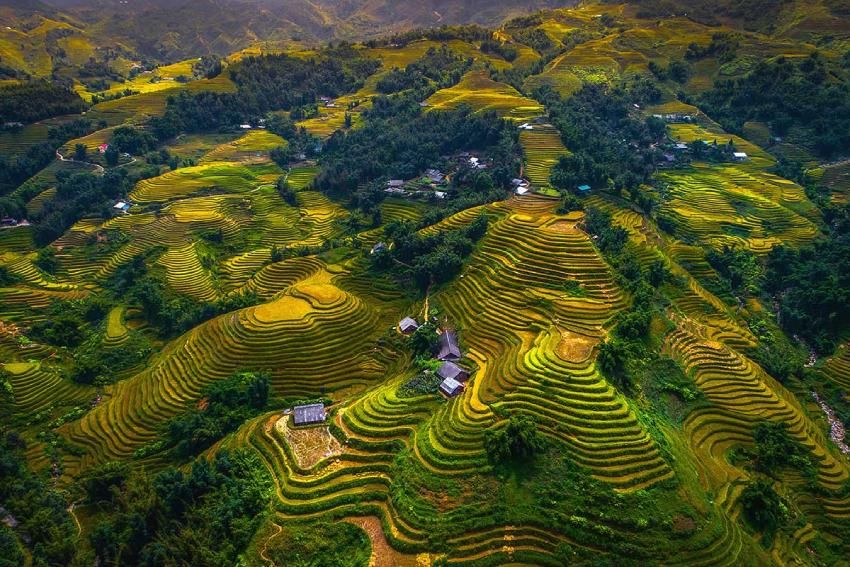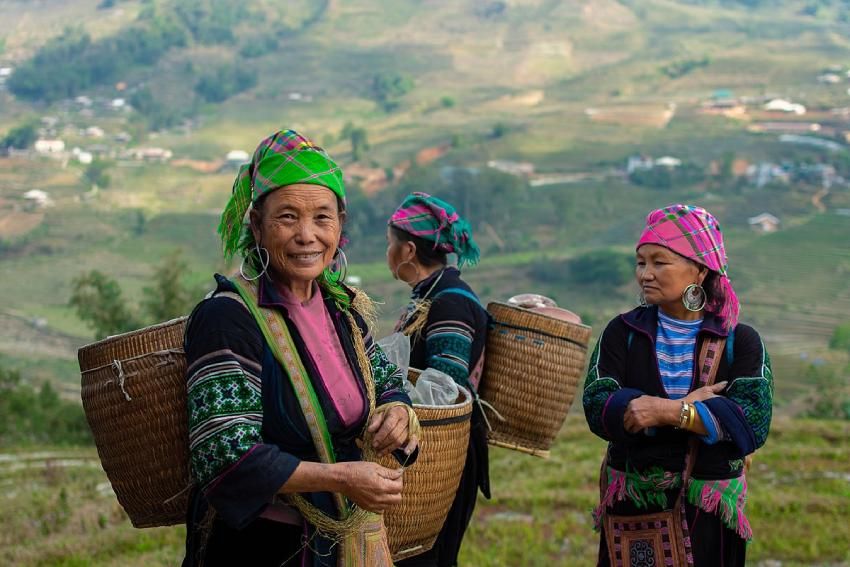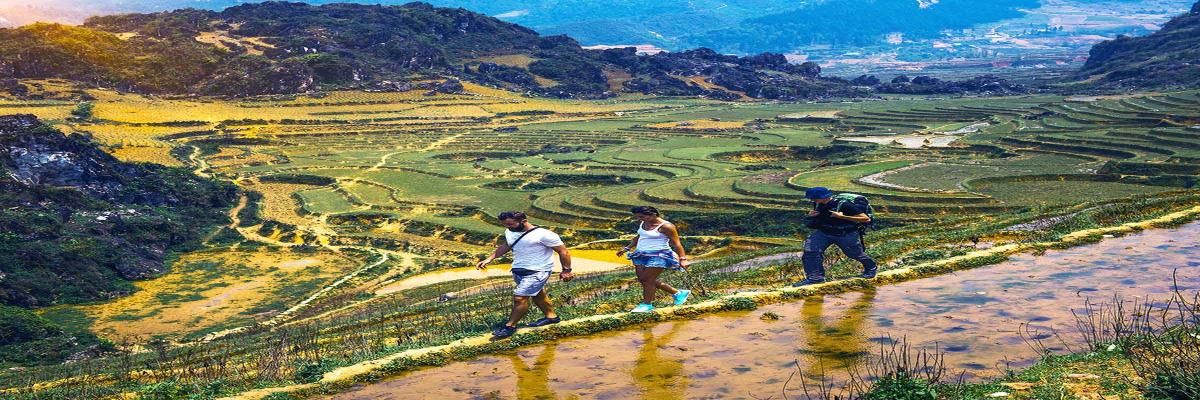Overview of Sapa and its Ethnic Minority Villages
You're about to discover the diverse cultural tapestry of this northern Vietnamese region, where traditional communities and their ways of life have been preserved for centuries. Sapa is a popular destination for travelers who want to experience cultural immersion in ethnic minority villages. The Hmong, Dao, Tay, Giay, and Xa Pho tribes live in these villages and continue to practice their traditional crafts, such as weaving, embroidery, blacksmithing, and silversmithing.

The beauty of Sapa lies not only in its breathtaking scenery but also in the vibrant culture that thrives within it. Each tribe has unique customs and traditions, evident in their clothing, food, and architecture. As you explore the different villages, you'll see how daily life unfolds: farmers tending to rice terraces on steep slopes with buffalos by their side or women weaving intricate patterns on a loom while chatting amongst themselves. You'll also come across markets selling locally produced goods like hand-woven bags or silver bracelets intricately designed with tribal motifs.
Trekking through the villages
If you're planning on trekking through the villages in Sapa, there are a variety of routes and trails that you can take. Some popular options include the Cat Cat Village trail, which takes about 3 hours to complete, and the Muong Hoa Valley trail, which is longer and takes around 6-7 hours. No matter which routes you choose, expect to be surrounded by stunning scenery and diverse ethnic minority communities.
Best routes and trails
The winding paths and hidden trails in these parts of Sapa are like puzzles waiting to be solved. Some routes and trails offer unique experiences beyond the beaten path. One of the most popular routes is through Hmong ethnic minority villages, where travelers can witness how they make their traditional clothing and learn about their way of life.

For nature photography enthusiasts, the Ta Van village trekking route offers breathtaking views of cascading rice terraces surrounded by lush green forests. The best time to visit is during the harvest season, when the fields turn golden yellow, creating a picturesque landscape perfect for capturing memorable photographs. Additionally, cultural immersion opportunities abound as you mingle with locals and witness traditional activities such as farming or weaving. Exploring Sapa's ethnic minority villages may seem daunting initially, but it's an adventure worth taking for those looking for unique experiences off the beaten path.
What to expect on the trek
Prepare for an unforgettable adventure as you trek through winding paths and hidden trails in Sapa's ethnic minority villages. While the breathtaking views of cascading rice terraces and lush green forests will leave you in awe, the trekking challenges will push you to your limits. The terrain can be steep, and the weather can be unpredictable, so bring appropriate gear for rain and sun.

Aside from the physical challenge, this trek also offers cultural immersion opportunities that are hard to come by elsewhere. You'll interact with locals who have lived in these remote areas for generations, learning about their customs and traditions firsthand. Don't be surprised if they invite you into their homes for a meal or offer you some locally made rice wine along the way. So pack your bags, lace up your boots, and get ready for an adventure that will leave you feeling free and alive.
Interacting with the locals
Don't miss out on the chance to connect with the warm and welcoming locals during your trek through Sapa's ethnic minority villages. Cultural immersion is one of the key highlights of this experience, and interacting with locals can provide a unique perspective on their way of life. Despite potential language barriers, you'll find that many residents are excited to meet travelers and eager to share their stories.
To make the most out of your interactions, here are three tips:
-
Bring a small gift as a token of appreciation for any hospitality shown.
-
Try learning some basic phrases in the local dialect—just saying hello or thank you can go a long way in breaking down language barriers.
-
Be respectful - always ask before taking photos and take care not to intrude on personal spaces or customs. By following these simple guidelines, you'll be able to leave a positive impression on both yourself and those you encounter during your trek through Sapa's villages.
The Hmong people
During your trek through their mountainous homeland, you'll be transported into the vibrant and unique world of Hmong culture. The Hmong people are one of Vietnam's largest ethnic minority groups, and they have a rich history that spans centuries. When you visit their villages, you will have the opportunity to see firsthand how they live and work and learn about their fascinating traditions.

One of the most exciting aspects of Hmong culture is their handicrafts. The Hmong people are skilled at making intricate embroidery, batik fabric, and silver jewelry. They use these crafts to decorate their traditional dress, an essential part of their cultural identity. For women, this includes brightly colored skirts and jackets with embroidered designs. Men wear black or blue jackets with silver buttons and cuffs. During your visit to a Hmong village, you may even be able to purchase some of these beautiful handicrafts to take home as souvenirs of your journey into this unique corner of Vietnam.
The Dao people
As you continue your journey through Vietnam's mountainous regions, you'll encounter the Dao people. These hardworking people make up one of the country's 54 distinct ethnic groups and have a population of around 800,000. They live in small villages scattered throughout the region, where they have preserved their traditional customs and way of life for centuries.

Here are some interesting facts about the Dao people that will surely capture your attention:
-
The Dao ethnic group is divided into subgroups with different dialects, fresh styles, and customs.
-
The women of the Red Dao subgroup are famous for their elaborate headdresses, which are made from red fabric and adorned with silver coins and tassels.
-
Theo Dao people are skilled artisans who create beautiful handicrafts such as embroidered fabrics, silver jewelry, and wooden furniture.
-
The men often wear black clothing with white turbans or hats made from bamboo leaves.
-
The Dao believe in animism and ancestor worship. They also practice shamanism to cure illnesses or communicate with spirits.
As you explore these unique villages, take time to appreciate the rich culture of the Dao people. You may even want to purchase some of their exquisite handicrafts as a reminder of your unforgettable experience in Sapa.
Tips for a successful trip
To ensure a memorable and enjoyable trip, follow these tips for success. First and foremost, make sure you pack the right essentials. Sapa is known for its diverse weather patterns, so bring clothing that can withstand both hot and cold temperatures. It's also important to have good hiking shoes, as you'll be walking on rough terrain during your village tour. Don't forget to bring sunscreen and insect repellent as well.
Another crucial tip is to practice cultural sensitivity when interacting with the locals. Keep an open mind and embrace the differences in culture. Respect their beliefs, traditions, and way of life by dressing appropriately (avoid revealing clothing) and asking permission before taking photos of them or their homes. Learn a few words in their dialects, like "hello" or "thank you," to show appreciation for their hospitality. By following these guidelines, you will have a successful trip and enriching experiences with the ethnic minority communities of Sapa.
Congratulations, you've just completed your trek through Sapa's ethnic minority villages! It was a unique and enriching experience that immersed you in the local culture and customs. You learned about the different ethnic groups that call Sapa home and had the opportunity to interact with them firsthand.




